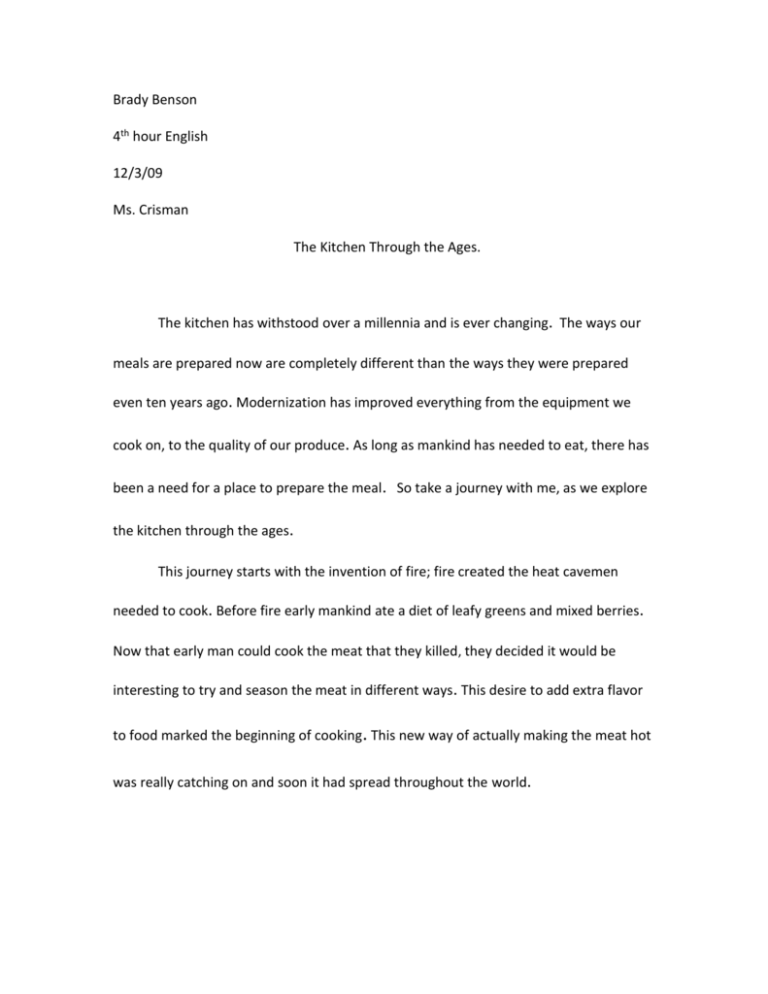Brady Benson 4th hour English 12/3/09 Ms. Crisman The Kitchen
advertisement

Brady Benson 4th hour English 12/3/09 Ms. Crisman The Kitchen Through the Ages. The kitchen has withstood over a millennia and is ever changing. The ways our meals are prepared now are completely different than the ways they were prepared even ten years ago. Modernization has improved everything from the equipment we cook on, to the quality of our produce. As long as mankind has needed to eat, there has been a need for a place to prepare the meal. So take a journey with me, as we explore the kitchen through the ages. This journey starts with the invention of fire; fire created the heat cavemen needed to cook. Before fire early mankind ate a diet of leafy greens and mixed berries. Now that early man could cook the meat that they killed, they decided it would be interesting to try and season the meat in different ways. This desire to add extra flavor to food marked the beginning of cooking. This new way of actually making the meat hot was really catching on and soon it had spread throughout the world. The first civilizations such as the Egyptians, and the Greeks built rooms into their homes especially designed for the cooking of meals (Wikipedia, Kitchen). These were simple rooms and often crude, rudimentary pots were hung over an open fire. Chimneys were a later invention. This concept of kitchens worked until the Romans came along and redefined the kitchen as a whole. In the Roman Empire many people were not wealthy enough to have a kitchen in their house, so the Romans came up with community kitchens. Some of these kitchens included a small bronze stove in which fires could be lit for cooking . The wealthiest of families had relatively well equipped kitchens in their homes, but these were farther away from social places because of smoke. These kitchens were run by slaves. During the middle ages the kitchen underwent a jump in technology. Early kitchens were situated in European longhouses with the fire under the highest part of the building. These buildings are very similar to the longhouses of the Native Americans. Many wealthy homes of the time also began to see multiple kitchens throughout the house. Each kitchen had a different placement depending of what it was used to cook. The first know stoves in Japan, called kamado (Wikipedia Kitchen), surfaced at about this time as well. The stoves were mostly clay and mortar based, and they had a hole in the top in which the rim of the pot would sit. The middle age kitchens were called “smoke kitchens” because they cooked on an open fire and the cooks were generally almost smoked out while they cooked. In castles and monasteries the kitchen was often in the same structure, but there were modifications due to social implications. During the time period it was socially unacceptable to have servants seen cooking ones food. To combat these adversities there was a separate set of spiral staircases that the servants would use to bring food to the upper levels. An example of one of these staircases can be found at Muchalls castle in Scotland (Wikipedia, Kitchen). With the invention of the chimney, kitchens started to take a turn in design. The hearth was moved from the center of the room to being on the wall. The temperature of the food was controlled by moving the pots higher or lower on the fire. Leonardo Da Vinci invented an automated system for turning the roasting spit (Wikipedia Kitchen); a propeller in the chimney made the spit turn all by itself. It was widely used in wealthy homes. In upper class homes the kitchens were being built as separate rooms and were operated by servants. The concept a chef or restaurant was not even thought of until 200 years later. The technology of the kitchen took leaps and bounds during the industrial revolution. The first jump was the invention of the cast iron stove, which enclosed the fire completely. This design was more efficient because the fire was enclosed and controlled. Early models of this stove were the Franklin stove and the Rumford stove. These stoves, however were designed for large kitchens and not for domestic use. It wasn’t until later that the stoves were designed for the home. Stoves during this time period were often fired with wood or coal and it wasn’t until the late 19 th century that gas was used as a heat source. The industrial revolution resulted in many advances in the technology of the kitchen, the industrial revolutions also caused social changes. The working class in the cities were housed under poor conditions and often had to share apartments with other families and night sleepers (unmarried men who paid for a bed at night) (Wikipedia Kitchen). The kitchen was often used as a living room, sleeping room, and sometimes a bathroom (sanitary conditions at the time were of little importance). However the middle and upper-class kitchens remained relatively unchanged. The kitchens were still in the basement and were operated by servants. In 1765 the first restaurant opened in Paris, 1765 by M Boulanger (CIA, 22). He was sued by the city of Paris in court for his concept but won the case and was allowed to continue. The importance of this is now restaurants were a concept and are starting to make an appearance. His restaurant broke the ice and allowed many to follow in his footsteps. The French revolution played a key role in restaurant proliferation; with the nobility gone their chefs had nowhere to continue working so they opened their own establishments. As restaurants became more sophisticated and refined, Antonin Caréme detailed many dishes and their sauces in his book La Cuisine Classique (1856). This changed the restaurant world forever; it created a guide, table d’ hóte for owners and operators to establish menus of simple items, although the menus provided little choice. The book also paved the way for a carte or list of suggestions from the kitchen. The á la carte restaurant had begun. Georges Auguste Escoffier is a name that goes hand-in-hand with the restaurant world; he was a world renowned chef and teacher. He is a creator of one of the first high end hotel establishments, the Ritz. (CIA, 26) He published a book that still has major influences today, Le Guide Culinaire. This book revolutionized food; it codified classic cuisines and made them simple and easy to master the techniques. He initiated the Kitchen brigade system which gave a more militaristic feel to the kitchen , and helped it become more organized. The Brigade system works like this the Chef de Cuisine (Kitchen Chef) is responsible for the management of the entire kitchen. The Sous-chef de Cuisine (Deputy Kitchen Chef) they receive orders directly from the Chef de Cuisine and represents the Chef de Cuisine when he or she isn’t around. After the Sous chef comes the Chef de Partie (Senior Chef) who is responsible for managing a given station and specializes in preparing particular dishes. The Cusinier or (Cook), this position is independent and usually prepares specific dishes at a station. Commis or (Junior Cook), they work in a specific station, but reports directly to the Chef de Partie. Apprenti(e) (Apprentice) are many times students gaining theoretical and practical training in school and work experiences in the kitchen. Saucier (Sauce maker/Sauté cook) prepares sauces, warm hors d’oeuvers, completes meat dishes, and in smaller restaurants complete fish dishes as well. Rotisseur (Roast Cook) manages a team of cooks that roasts, broils, and deep fries dishes. Patissier (Pastry Cook) prepares deserts and other meal end sweets for restaurants. Last but not least the Plongeur (Dish Washer) cleans dishes and utensils and may be entrusted with basic preparatory jobs. These positions are viable only with very large restaurants with a multitude of staff. There are many modifications of this system and that’s part of the brilliance is that it can be adapted for use in many different situations. If there is a kitchen with only 3 chefs on the line you can adapt the positions of the brigade system to suite the 3 people working and their stations. The brigade system works very much like a countries military system. All of these positions look to the position above them and there is only one “commander in chief”. These positions are ever changing with the needs and wants of the restaurant. As the Kitchen moves into the 20th century the chef starts to become redefined. Because of the United State involvement in two world wars over the course of this century, these men have been overseas and developed a palate for new foods, and this lead to a need for chefs that know more classical techniques. Thus modern cooking schools and instruction institutions where classical methods of Caréme and Escoffier are taught become popular. With our country being in wars opened job opportunities to boys who from the fresh age of 18 had been in the service and never learned a job skill, Cooking was one of the easiest to learn after knowing nothing but military. Thanks in part to the brigade system being so similar to military ranking systems. The technical advances of the 20th century are also to be marveled at. The development of the microwave had huge implications in the kitchen. Things could be cooked quickly, which fit in with the social changes of the time period as well. People were starting to live life in the fast lane. House wives were becoming a thing of the past. Two income families were starting to become the norm. With women starting to join the workforce the kitchen in the home needed to become revolutionized to keep up with the busy lifestyles. With these social changes coming about the industrial kitchen has to adapt to maintain a grip of the foodservice industry. This social change allowed the growth of the fast food scene, another concept of restaurants where the menu is small and the food takes usually under five minutes to cook. These “burger joints” were moving away from the traditional restaurant scene. The menu and red wine dining were being outshined by burger joints and sub shops, because of convenience. Society still looked at restaurants with an air of high-class. Fancy dining was becoming something for only the rich and upper-class to enjoy. Which has been the norm for most of history, but that is about to change with star chefs becoming household names. With the media age coming around the chef has become more of a celebrity. Today’s chefs are admired for their skill, craftsmanship, skill, and creativity. Some chefs are considered house-hold names, with all this recognition it helps gather young aspiring chefs to join the business. The Food Network has been the best thing for chefs and restaurants alike. Now that chefs have an air about them it is easier for them to be taken seriously as artist and creators. Branches of shows on Prime Time networks are also helping the industry. Kids, instead of wanting to be firemen of police men want to be chefs, they want to cook like Bobby Flay or Guy Ferrie. The foodservice business currently generates 2.1 billion dollars in total gross sales (Ruhlman 106). This is a very important share of the American market and is respectable. It is estimates that there will at least 1.5 million more jobs in the food service industry than there will be people to fill them ( The Culinary Institute of America, 32). These jobs that the foodservice industry creates are essential to the economy. They provide places for work which require minimal training and very hands on experience. These jobs are also very easy to learn which benefit the unemployed, they don’t have to go back to college to earn a foodservice degree or anything like that. Dinning has become more of a form of entertainment in the 21st century. People used to go to dinner and then leave to go to the theater, or to go dancing. Now people go out to eat to enjoy eating. Lingering over dinner at a restaurant has become the evening. Once again the media age helps here. More people see shows like “Diners, Drive-Ins, and Dives” and say I want to eat at those restaurants. Going out to eat has become fun. People want to spend money on food even though we are in a recession. People still have to eat and that helps out foodservice professionals. Advances in technology have also helped the farmers that supply our restaurants and home kitchens. More of the focus has now been put to organic foods and whole foods. This is providing our society with a healthier, more balanced diet. With the fast food bursts of the late 80’s America wasn’t the healthiest, but with stress on organic foods our society is becoming healthier every day. The evolution of the kitchen has encompassed many changes and has gone through several updates and throwback editions. But the fact remains that cooking and preparing food is still an everyday occurrence in our lives… and the best place to prepare the meal is the kitchen.






